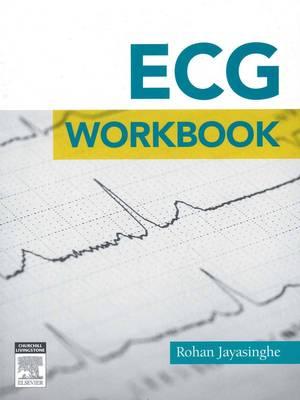Jayasinghe, S. Rohan. ECG Workbook, Australia: Elsevier; 2012.
RRP: $59.95
This is an Elsevier supported book review
Like tools are to a plumber, correct ECG interpretations are to a doctor. ECGs are the basis of diagnosis for many of the patients that walk through our hospital doors. Consider this: how many patients do you see that don’t have an ECG tucked into their notes? And how often have you looked at an ECG and quietly thought to yourself, “what on earth is going on?” before sheepishly praying that the consultant doesn’t ask you to interpret it? Mastering an ECG is the foundation of being a doctor, an essential skill that you will not be able to shy away from. So in a quest to find a tool that would ease my ECG fears, I stumbled across this clever little book.
Jayasinghe takes both a logical and systematic approach in this text as he emphasizes the “importance of treating a patient and not an ECG”. Readers are provided with real life case studies and guided through a stepwise process to interpret an ECG. This provides an opportunity to not only practice this new skill set but also to formulate a clinical diagnosis and decide on appropriate and optimal management.
The workbook is divided into three convenient user-friendly sections.
Section 1 takes readers on a journey through the fundamentals of ECGs. Essential knowledge on cardiac conduction physiology is revisited, before explaining the derivation of the modern electrocardiogram by the Nobel prize-winning Dutch physician William Eithoven. Difficult concepts (for example, the accurate determination of the cardiac axis) are explained using both the two and three lead method. This is discussed before using a difficult yet more accurate methodical explanation of its relation to a hexa-axial reference system. The importance of correct limb placement is clarified before the author dives into providing the reader with six practical rules that should be applied when ‘eyeballing’ any ECG. This framework then provides an organized line of attack when attempting to read an ECG. Overall Section 1 studies the ‘normal’ ECG and highlights life-threatening ECG changes that require urgent therapeutic intervention.
Section 2 explores ECG based diagnosis through interpreting pathological ECGs, highlighting areas of study such as abnormalities in the P wave, PR segment, QRS complex, Q wave, R wave, S wave and ST segments. This section then focuses on STEMI associated ECG changes. The author should be commended for including pathologies with mixed ECG changes which are commonly seen in clinical settings such as pulmonary embolism, subarachnoid haemorrhage, takotsubo cardiomyopathy, hypokalaemia and hyperkalaemia before drawing the reader’s attention to drug induced ECG changes.
Everyone knows that practice makes perfect and that the key to mastering any new skill set is practice. The final section of this innovative book is clearly set out in workbook format containing a series of ECG tracings linked to a clinical scenario. A fill in worksheet guides the reader to interpret the ECG using the strategic framework taught in Section 1.
Many texts that attempt to help the reader master the art of ECG interpretation lack this crucial worksheet approach, which facilitates repetitive learning and ultimately allows the student to master the ability to interpret ECGs in the clinical context. Each case is followed by the answer, which has been carefully set out in the same systematic framework taught throughout the text. The author has clearly placed much effort into ensuring that the reader understands the importance of using a stepwise approach when faced with this somewhat daunting task. Additionally, the author endeavours to engage readers to teach them to stratify the significance of the ECG findings based on clinical relevance and urgency. This is a refreshing approach from a medical textbook.
Self assessment enables the reader to build confidence and precision, to gauge their competence and to hone weaknesses. Key concepts can be revisited and mastered as they work their way through this glorious all-in-one paperback.
This short but sweet text provides a comprehensive and systematic approach to learning ECG interpretation whilst ensuring relevancy to real life scenarios. The only criticism I have of this clever little lifesaver, which is small enough to effortlessly carry around hospital, is that it should be available in hard-back! All things considered, the author, an interventional cardiologist, should be applauded as he has succeeded in providing readers with the perfect balance of mastering the art of ECG interpretation whilst being able to apply it to diagnostic situations without getting lost in the detail.
Correspondence
A Lalji: liyah10@hotmail.com


